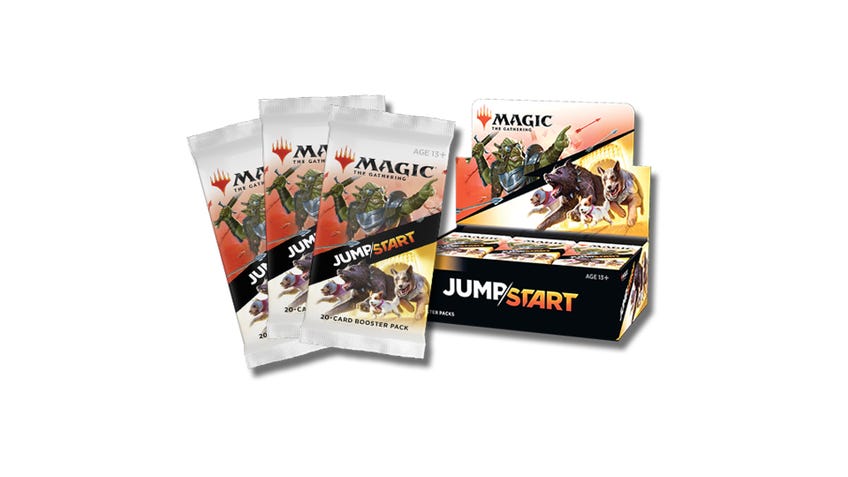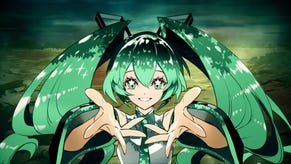Magic: The Gathering’s hugely entertaining new format Jumpstart is the perfect introduction to the TCG
Two halves make a whole lot of fun.
Supplementary Magic: The Gathering products - as in, the ones that aren’t designed entirely for people who already play the game - can be a little erratic when it comes to delivering upon an idea. The central promise of many of these “game-in-a-box” releases tends to be to try and allow a space for long-time fans to play alongside those who are new to the game.
The issue comes from the complexity of MTG at a high level. You need to be able to understand not only the potential meta cards and decks you’ll come up against - those popular in tournaments, typically comprising the best decks around as a result - but also predict the moves your opponent will make, have answers to those moves and ultimately win the game.
When you break down the various phases, timings of different card types and deck construction options, you end up with a game that is quite tough to get into. It’s easy to forget as a long-time player, but the beginnings of MTG are nothing like competitive play. At first, you’re playing to have fun; you don’t care much about formats, and playing a couple of games with 97-card decks is amazing. Later on, players tend to become more competitive and start fine-tuning decks to stand a chance in tournaments (or just using the web to build the best deck at the time).
Jumpstart is the latest attempt by MTG maker Wizards of the Coast to act as a small glimpse into the world of MTG, and an attempt to turn the CCG into a far more digestible style of game. The format removes a lot of the complexity of the game while retaining the core experience that makes MTG so enjoyable.
Jumpstart removes a lot of the complexity of the game while retaining the core experience that makes MTG so enjoyable.
At the heart of Jumpstart are booster packs with 20 cards inside. Each pack has a theme, whether that’s adding counters to creatures, every creature being a cat or being centred around a powerful planeswalker. You play Jumpstart by opening up two packs, shuffling them together and then doing battle against someone else who has done the same. This means you don’t have to worry about building a deck, or choosing which mana colours to play.
While building a Magic: The Gathering deck is a lot of fun, many people find it frustrating to constantly face-off against the meta decks with their own brews. This is especially true of newer MTG players, so removing deck construction entirely from the equation means that more people can jump in. Not only that, but it means that everybody starts on an equal playing field - at least as far as the cards are concerned.

There are different rarities to the booster packs; one in three packs will have two rare cards instead of one, meaning you can end up with more rares than your opponent. For the most part, however, it’s all fair. That makes it a really great way to not only play Magic: The Gathering, but also teach or learn it. Jumpstart feels like the first time that Wizards of the Coast has managed to deliver on the idea of a simplified version of MTG - one that genuinely appeals to both new and old players.
It's not only a really great way to play Magic: The Gathering, but also teach or learn it.
It also captures the essence of one of the most chaotic forms of MTG: a style of play called Pack Wars. In Pack Wars, you and your opponent open a single booster, sleeve it up and combine with either two of each Basic land or one of each of the dual-colour Guildgate lands. You then play through your tiny deck, with no idea of what cards you have at your disposal.
Pack Wars is a silly way of opening boosters, but it’s a lot more fun than simply tearing them open, and the unease of not knowing what’s in your deck is sublime. The downside is that you can only do it once per pack - after that, you know what you’ve got, so it’s far less entertaining.

Jumpstart, on the other hand, is replayable. Let’s say you buy a box of Jumpstart - which hopefully shouldn’t be that hard thanks to its unlimited physical print run. (There are shortages at the moment due to COVID-19, so don’t buy an overpriced box.) You’ve now got 24 packs to open, which means 12 complete decks at once, let alone all of the combinations possible by swapping those around.
You can easily separate the themed packs, allowing you to get them out again whenever you want, and combine them either at random or by picking two you think would work well together. There are a lot of ways to keep playing with Jumpstart once you’ve opened it up, too.
Thanks to the way Jumpstart is designed, common and uncommon cards aren’t worthless; they all have a place in the format. A lot of MTG players have boxes filled with cards they simply don’t use. Jumpstart won’t have that issue if you’re happy to keep messing around with it. Each card will still fit into a theme, and you can still mix those themes together to create a new deck and then battle it out with your friends. This is one of the few times where a MTG box doesn’t become just a pile of cards once you’ve opened it. Instead, you’ve got a great way to play that doesn’t need to worry about formats or deck construction - you can just shuffle and play.
Jumpstart may well be the most accessible version of MTG there’s ever been. It takes so much out of the game without diminishing the enjoyment that you can find in it. It’s worth celebrating for that fact alone, but it gets better when you’re actually playing it, too.
Jumpstart may well be the most accessible version of MTG there’s ever been.
Each match of Jumpstart manages to offer something a bit different. The same could be said of MTG in general, but competitive play is all about reducing the variants as much as possible. Jumpstart isn’t interested in being competitive; it’s interested in being entertaining. That means you can end up with a deck that’s all about reanimating dead creatures mixed with a deck that’s all about cats.
You can mix wildly different game plans together and still come away with a surprisingly cohesive deck. It’s kind of astounding how much fun Jumpstart is to play. When it comes down to it, this isn’t a set where the individual cards matter that much - it’s all about the gameplay.

That said, there are some incredible reprints available in the set, alongside some very cool new cards too. Cards like Craterhoof Behemoth, Kira, Great Glass-Spinner and Oracle of Mul Daya are excellent reprints that, thanks to the unlimited print run, should be far more affordable once there are more copies in the wild.
The new cards are exciting, too. Allosaurus Shepherd is a one-mana Green creature that can’t be countered, and also stops all of your Green spells from being countered. On top of that, it can turn all of your creatures into 5/5s for only six mana. This is the kind of thing that could see play in a Legacy Elves deck.
Then you’ve got Bruvac the Grandiloquent, who doubles any milling you cause your opponent to do - moving cards directly from their library to their graveyard. It’s unlikely to affect competitive formats, but Commander players are going to absolutely love it. Well, those who play mill will love it - everyone else will be sick of seeing their expertly-crafted decks end up in their graveyard.
There are a few other standout cards too, such as Tinybones, Trinket Thief, who is both adorable and powerful (and incredibly expensive at the moment). Jumpstart manages to make its target audience everyone, succeeding in nearly every respect.

There’s only one real downside of the format, and that’s the MTG Arena version of Jumpstart. Due to reasons that only Wizards of the Coast itself can be sure of, the cards in Jumpstart on Arena are not the same as they are on the tabletop. While this doesn’t impact the paper version of the set, it is a disconcerting way of doing things.
The Arena version of Jumpstart feels a bit weak compared to the tabletop.
This means that a lot of the cool reprints aren’t available, and the power level of some of the decks is lowered considerably. The Arena version feels a bit weak comparatively - while that isn’t a total dealbreaker, it does make you wonder what the thinking behind the move was.
Overall, Jumpstart is the best possible introduction to MTG that anybody can hope for. It is simple enough for new players to grasp, complex enough that older players won’t feel babied and replayable enough that a single box could keep you trying a different deck every day for months. It’s hard to overstate how much fun there is to be had here, in what really does feel like a nigh-perfect release.










